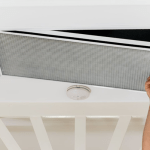Previously owned houses are generally designed around the previous owner; therefore, a variety of home improvement projects may be required in order to meet your family’s specific needs and tastes. Although it may be tempting to start some of your home improvement projects, there are four vital steps to take before you make any upgrades or remodeling investments.
Foundation Inspection
Whether you’ve purchased a house with a basement or one built on a concrete slab, a thorough inspection of the foundation should be conducted. For homes with a basement, the signs for foundation settlement include cracks in the concrete floor and walls. Minor cracks in the concrete are not major concerns; however, if you can fit a penny into the gap or see that one edge is higher than the other? You may need to call a soil remediation company for polyurethane grout injection to stabilize and lift your home back to safe settlement thresholds.
For homes that are constructed on concrete slabs, it can be a little harder to notice the signs of foundation settlement because the slab is generally covered by flooring materials. Some of the signs for a sinking slab include uneven floors and countertops, jagged cracks in the ceilings and walls, and windows and doors that don’t work properly.
Roof Inspection
You can start inside the house by looking for any signs of water stains on the ceilings. Then go into the attic and expand your search by looking for any signs of daylight coming in through the roof or signs of moisture either on the rafters, plywood roof sheathing or wet insulation. Working your way up to the roof from the interior of the house can help you pinpoint the location of the leak on the roof.
Your next step is to find a ladder and get on your roof to inspect for any signs of damage or find the location of the breach if you happened to discover one? Replace any broken, missing or curled shingles and add new roofing sealant around fixtures such as skylights, vents or chimneys.
Siding Inspection
During your walk around the perimeter of the house, you should be looking for loose or missing pieces of siding, broken gutters, loose fascia boards and trim, and gaps around the windows and doors. It’s important to make these necessary repairs to the exterior of your house in order to make it watertight.
Plumbing Inspection
Conducting a thorough inspection of your plumbing is a vital step that is oftentimes overlooked. You should be looking at the water and drain lines in the basement and under all of the sinks in the house for any signs of leaks. This is also a good time to check the age of your hot water heater. If you have an outdated hot water heater, you may want to consider hiring a professional plumber to install a more modern and energy-efficient appliance.
Performing a solid inspection of your home’s infrastructure is key to preventing unnecessary repairs to newly renovated home improvement projects. If you take the steps mentioned above before you start your home improvement projects, you can save yourself a lot of headaches and money in the long run.







